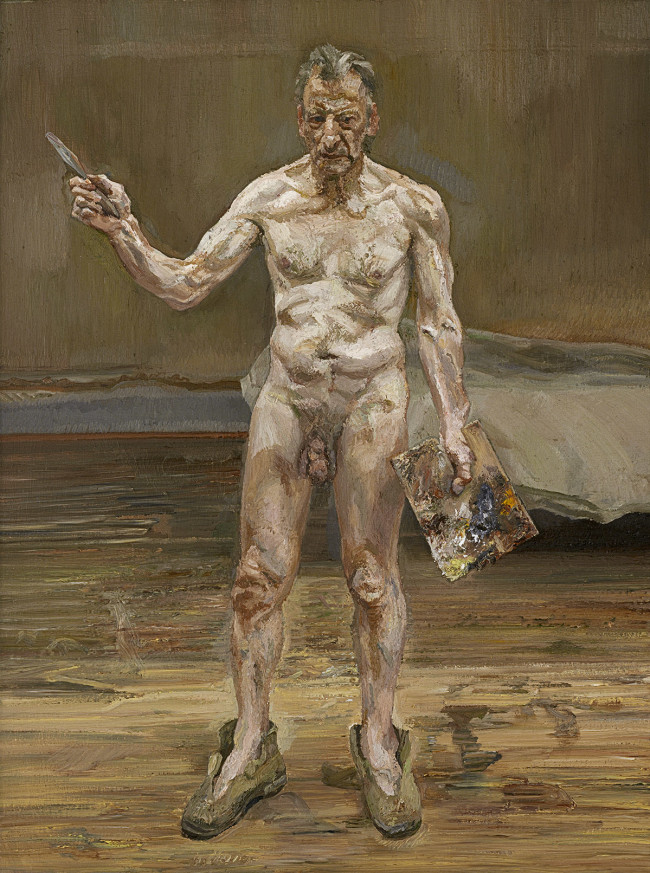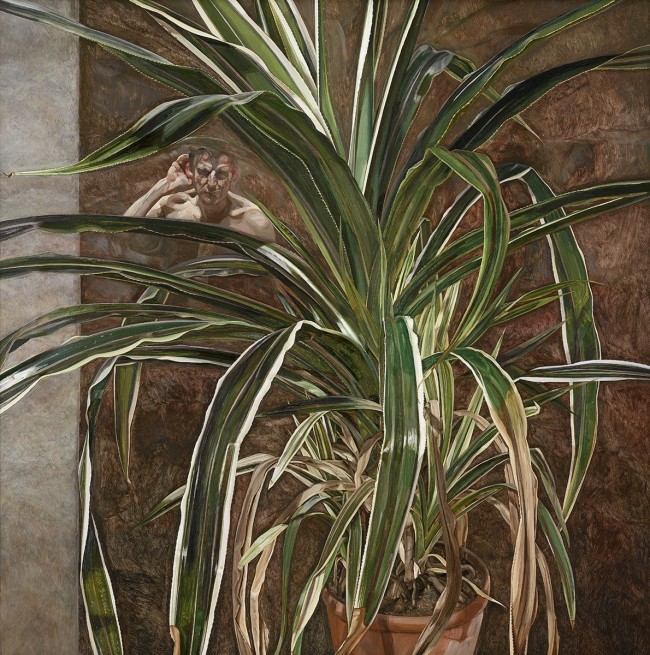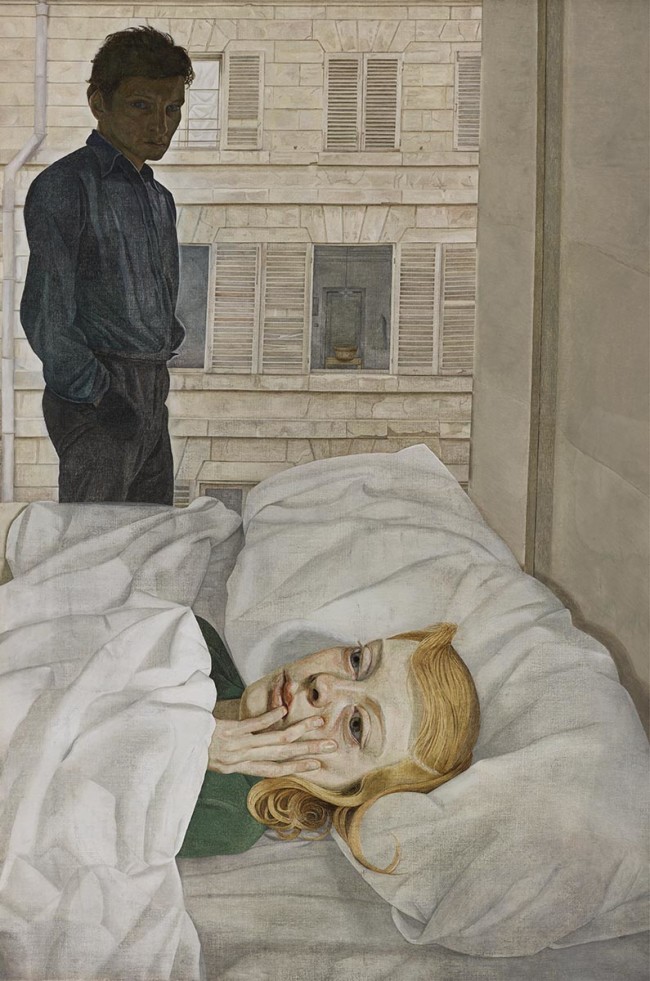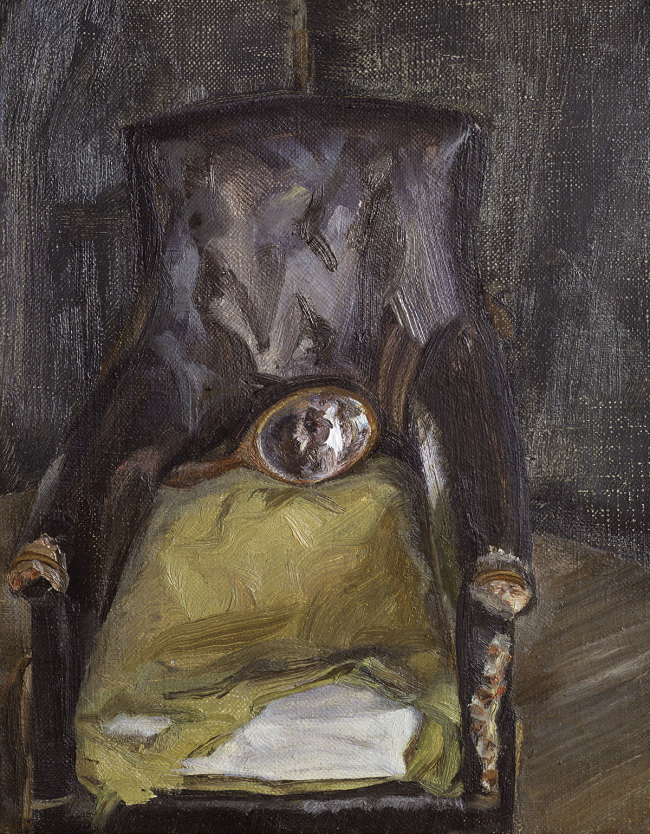Lucian Freud Full Body Drawing
A beginner's guide to Lucian Freud
Published 22 Oct 2019
As we unite more than 50 of Lucian Freud'due south self-portraits for the outset time e'er, here's a handy guide to get to know the man whose painted, printed and drawn figure is in our galleries this autumn.
-
He is one of art'south almost influential portraitists
Lucian Freud (1922–2011) changed how we expect at people. He filled his canvases with bodies rarely given space elsewhere: fat bodies, ageing bodies, queer bodies, wearied bodies. Some accept described his portraits every bit ruthless, pitiless, clinical and vicious; others run into them as intimate and honest records of humanity. He once described himself equally "a sort of biologist", interested in "the insides and undersides of things". Freud turned his scrutinising center on his own changing body at every stage of his life, experimenting relentlessly with foreign angles and arrangements that pushed the boundaries of self-portraiture. Swain artist Antony Gormley has described Freud's practice every bit a "resilient exploration as witness to those around him and to his ain existence".
-
-

Lucian Freud, Painter Working, Reflection, 1993.
He was an adopted Englishman
Freud was born in Berlin in 1922 to a Jewish family (which included his grandad, the psychoanalyst Sigmund Freud), but they left for London when Hitler came to power 11 years later. Freud spent the rest of his life in the capital, befriending people from all corners of social club for his portraits. He could ofttimes exist constitute drinking and betting in Soho's confined and clubs from the 1940s to the 1960s, or (towards the end of his life) having long lunches with eccentric Londoners at The Wolseley, a lavish eatery just around the corner from the Regal Academy. Equally an adult, Freud said that moving to England was "Linked to my luck… London, the identify I adopt in every style to anywhere I've been."
-
-
-
He tried to live a private life… but failed
Freud claimed that "My first word was 'alleine' which means 'solitary'. 'Leave me alone': I always liked existence on my ain." When people tried to take his photo, he quickly shielded his face with his hand (he did this even in his official photo with the Queen when he accepted his Gild of Merit – though she used the image for her Christmas carte that year anyway). He rejected the idea that an artist'south life mattered to his art and rarely gave interviews, but his creative legacy is entwined with stories of his personal exploits. He used some of his 14 (best-selling) children as sitters for paintings, but was far from a conventional father figure ("communal life", he once said, "has never had much appeal"). He made Cocky-portrait with a Black Eye just hours after a fist fight with a cab driver. In his only slice of writing on his own art, Freud wrote that "A painter must think of everything he sees as existence there entirely for his own use and pleasure", and he lived by that principle his entire life.

Lucian Freud, Interior with Plant, Reflection Listening, (Cocky-Portrait), 1967-8.
-
-
-

Lucian Freud, Hotel Bedroom, 1954.
He didn't always paint those notorious nudes
In his early on career Freud took influence from Surrealist artists who depicted a reality made strange. Their practices were in turn greatly informed by texts written past the psychoanalyst Sigmund Freud – the artist'due south gramps. Like the Surrealists, Freud combined detailed observation with an unsettling sense of not-quite-reality. His portraits were linear, graphic, make clean and precise – and his subjects were dressed. In his 40s, after years of scrutinising sitters for hours each day (oft perched simply a pes or two abroad, with the sheet balanced on his knees), his eyes were exhausted. Equally a outcome he slowly started painting more loosely and freely. He swapped his brushes from soft sable to bristly squealer'due south hair snipped down to a stub. He started layering canvases with thick, clotted paint. He decided that "I want the pigment to feel like flesh", and the more painting he did, the more flesh there was. As he came to realise: "I am actually interested in people every bit animals. Part of my liking to work from them naked is for that reason. Because I can see more."
-
-
He painted more than 160 people
…including Queen Elizabeth, though she remained fully clothed. She joined Freud's motley crew of performance artists, members of the criminal underworld, Lord Rothschild, a restauranteur, Kate Moss, a jobcentre manager, duchesses, drag queens, some of his 14 children, his mum, and himself. He worked on three or iv portraits at once, with each subject painted for hours at a time over several years (many were positioned lying downwards then they could sleep while he worked). He demanded that his models were "punctual, patient and nocturnal". The artist David Hockney RA (who sabbatum for Freud for 120 hours in 2002) told Vanity Fair, "I was fascinated past his process… He wanted you to talk so he could sentry how your face moved. He had these incredible eyes that sort of pierced into yous, and I could tell when he was working on a specific part of my face, my left cheek or something. Considering those eyes would exist peering in: peering and piercing."
-
-

Lucian Freud, Hand Mirror on Chair, 1966.
His cocky-portraits span his career
From his commencement cocky-portrait at historic period 17 to his concluding one executed 64 years later on, Freud committed himself to canvass throughout his life. To do so, he said, "y'all've got to try and paint yourself as another person". His studio banana of 20 years, David Dawson, in one case said that "It's heavy going for him psychologically, but he sees information technology every bit a sort of a duty." He refused to pigment from photographs, since "the aura given out by a person or object is as much a role of them as their flesh. The result that they make in space is equally leap up with them equally might exist their colour or smell." Instead, he oftentimes painted his reflection using mirrors of various sizes – and included references to this in both the works and their titles. Ultimately, he said, an artist should exist present in his piece of work "no more God in nature. The homo is nix; the work is everything."
-
-
-
See Lucian Freud's self-portraits at the RA
27 October 2019 — 26 January 2020
In a earth first, this autumn we're uniting Lucian Freud's self-portraits in one extraordinary exhibition. See more than fifty paintings, prints and drawings in which this infamous figure of British fine art turns his unflinching centre firmly on himself.

-
hennessywhavillat81.blogspot.com
Source: https://www.royalacademy.org.uk/article/lucian-freud-self-portraits-beginners-guide